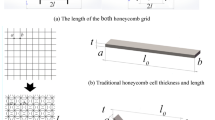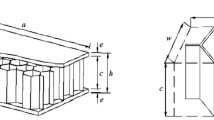Abstract
For the support structure of wind tunnel tests, a honeycomb sandwich structure is used to embed the wind tunnel tail brace to form a honeycole test process. Using Rayleigh beam theory and equivalent method, the lateral bending dynamic model of the support rod is solved and the natural frequency expression of the lateral bending vibration of the support rod is obtained. Taking the static strength of the support rod as the optimization design objective, the honeycomb sandwich structure was quantitatively described and the optimal design scheme was obtained through orthogonal experiments. The simulation and calculation results of the proposed support and hollow support are verified and compared with each other. The error between the first three natural frequencies of the honeycomb sandwich support given in this article and the simulation results is less than 9.52 %, which proves that the calculation results are relatively accurate. On the premise of meeting the constraints and load requirements, the low order resonant deformation of the transient dynamics simulation analysis is reduced by 30.27 %, significantly improving the vibration damping ability of the wind tunnel support system.
Similar content being viewed by others
References
L. Yu, X. H. Yang, X. P. Kou, K. C. Zeng and B. B. Lv, Experiment on active vibration reduction system for transonic wind tunnel model, Journal of Nanjing University of Aeronautics and Astronautics, 51(4) (2019) 526–533.
C. P. Young, Jr, T. G. Popernack, Jr and B. Gloss, National transonic facility model and model support vibration problems, 16th Aerodynamic Ground Testing Conference, Seattle, USA (1990).
E. John, National transonic facility model and tunnel vibrations, 35th Aerospace Sciences Meeting and Exhibit, Reno, USA (1997).
J. Pan, Optimal design and analysis verification of constrained damping wind tunnel struts, Master’s Thesis, Shandong University, China (2020).
E. X. Yang, Design of high angle of attack tensioning and tail bracing combined support equipment, Mechanical Engineer (7) (2005) 113–114.
J. J. Gao and R. S. Jiao, Development of mounting forks system in FL-8 low speed wind tunnel, Experimental Fluid Mechanics, 25(6) (2011) 88–91.
Z. J. Li, Q. S. Yang and R. Fang, Crushing performances of Kirigami modified honeycomb structure in three axial directions, Thin-Walled Structures, 160 (2021) 107365.
A. Ashab, D. Ruan and G. X. Lu, Combined compression-shear behavior of aluminum honeycombs, Key Engineering Materials, 626 (2014) 127–132.
L. J. Gibson and M. F. Ashby, Cellular Solids: Structure and Properties, Cambridge University Press, UK (1997).
L. Aktay, A. F. Johnson and B.-H. Kröplin, Numerical modelling of honeycomb core crush behaviour, Engineering Fracture Mechanics, 75(9) (2008) 2616–2630.
M. H. Fu and J. R. Yin, Equivalent elastic parameters of honeycomb core layer, Journal of Mechanics, 31(1) (1999) 113–118.
Y. X. Shen, Design and optimization of honeycomb curved sandwich structure engine hood, Master’s Thesis, Dalian University of Technology, China (2021).
D. F. Xu and W. X. Yao, Fatigue life model for honeycomb sandwich structures, Mechanical Strength, 43(2) (2021) 404–411.
L. Lu, Z. J. Lu, M. Yan, C. J. Liu and Y. X. Xiong, Study on energy absorption and impact stability of series honeycomb, Journal of Central South University, 48(7) (2017) 1951–1956.
J. L. Su, J. D. Wu and Y. L. Liu, Research progress in the elasticity and impact resistance of honeycomb structural mechanics metamaterials, Materials Engineering, 47(8) (2019) 49–58.
M. Jaafar, M. Nouari and H. Makich, 3D numerical modeling and experimental validation of machining Nomex® honeycomb materials, Int. J. Adv. Manuf Technol, 115 (2021) 2853–2872.
Y. Xia, R. Y. Ge and J. P. Wang, Differential quadrature method for steady-state harmonic vibration of variable cross-section Euler-Bernoulli beams, Journal of Anhui Engineering University, 36(4) (2021) 56–63.
D. G. Pan, S. C. Wu and W. Zhang, Free vibration analysis of Timoshenko cantilever beam with variable cross-section, Civil Architecture and Environmental Engineering, 31(3) (2009) 25–28.
A. Y. Tang and G. Prince, Natural frequency of transverse vibration of cantilever rayleigh beam, Journal of Jishou University, 38(2) (2017) 21–26.
G. Y. Cui, Research on linear and nonlinear static and dynamic numerical analysis methods for honeycomb sandwich shells, Doctoral Thesis, Tsinghua University, China (1995).
J. R. Tang, J. Zhu and J. X. Yu, Simulation and analysis of bending characteristics of curved honeycomb panels, Modern Defense Technology, 44(5) (2016) 186–193.
Y. W. Song, C. H. Yang, X. F. Shi and P. Xi, Parametric finite element modeling method for hexagonal honeycomb sandwich panels, Journal of Computer Aided Design and Graphics, 27(1) (2015) 175–183.
Orthogonal Experimental Design Methodology, Orthogonal Experimental Design Method, Shanghai Science and Technology Press, China (1979).
D. Jiangsu, X. B. Ziran and B. Kexue, Side structure optimization of multi-purpose passenger vehicle based on side collision, Journal of Jiangsu University-Natural Science Edition, 41(1) (2020) 15–45.
Y. F. Gu, Orthogonal experimental design of wind turbine tower structure based on finite element analysis, Wind Energy, 29 (7) 78–83.
H. Q. Wan and Y. X. Wang, An investigation on the new-type high-damping damper for warp knitting machine, Knitting Industries (2) (2005) 3–4.
Acknowledgments
This work was supported by the National Natural Science Foundation of China under Grant 12172210.
Author information
Authors and Affiliations
Corresponding author
Additional information
Hao Huang received his bachelor’s degree in engineering from Shanghai Electric Power University in Shanghai, China, in 2022. He is currently pursuing his master’s degree at the Shanghai School of Energy and Mechanical Engineering. He is dedicated to the research of wind tunnel tail strut vibration reduction.
Qingpeng Han received the Ph.D. degree from Zhejiang University, Hangzhou, China, in 2007. He is currently an Associate Professor with the College of Energy and Mechanical Engineering, Shanghai University of Electric Power, Shanghai, China. His current research interests include the design and development of digital acquisition instruments and nonlinear analysis of vibration signals.
Rights and permissions
About this article
Cite this article
Huang, H., Han, Q., Wu, B. et al. Design and vibration reduction performance of honeycomb sandwich support rod for wind tunnel. J Mech Sci Technol 38, 527–539 (2024). https://doi.org/10.1007/s12206-024-0103-3
Received:
Revised:
Accepted:
Published:
Issue Date:
DOI: https://doi.org/10.1007/s12206-024-0103-3




